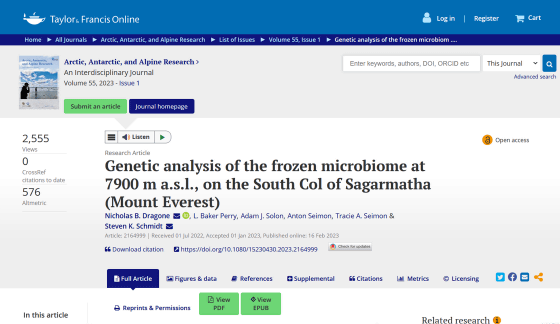Everest's ground preserves bacteria released by climbers when they cough or sneeze

Known as the world's highest mountain, Everest is visited by many climbers every year, and despite its harsh environment, it is a place where many people come and go. A new study found that 'even at an altitude of about 8000m near the summit of Everest, bacteria brought by climbers are preserved.'
Full article: Genetic analysis of the frozen microbiome at 7900 m asl, on the South Col of Sagarmatha (Mount Everest)

When someone sneezes on Everest, their germs can last for centuries | CU Boulder Today | University of Colorado Boulder
https://www.colorado.edu/today/2023/03/14/when-someone-sneezes-everest-their-germs-can-last-centuries
Everest Is Preserving The Germs Coughed And Sneezed Out by Climbers : ScienceAlert
https://www.sciencealert.com/everest-is-preserving-the-germs-coughed-and-sneezed-out-by-climbers
Hundreds of climbers visit Everest at an altitude of 8848 m annually, and the climbing route has marks left by past climbers and ropes for climbing, as well as the frozen bodies of climbers who have been in distress. etc. are also left.
In order to deepen our understanding of the relationship between altitude and the habitat of microorganisms, a research team such as the University of Colorado in the United States collected soil samples at a point called South Col at an altitude of about 7900m, which is the final camp site on the Nepal side route. Analyzed. The South Col is a harsh environment with almost no snowfall due to strong winds, but the temperature often reaches -33 degrees Celsius, and the atmospheric pressure is one-third of that at sea level.

by
The research team used genetic sequencing and culture techniques to identify the DNA of living and dead microorganisms present in the samples. They also conducted extensive bioinformatics analysis of DNA sequences to investigate microbial diversity.
Analysis showed that the most abundant microorganism in the sample was the Naganishia genus fungus, which can withstand extreme cold and UV light. However, they also found DNA from microorganisms closely related to humans, such as staphylococci , one of the most common bacteria on human skin and nose, and streptococci , commonly found in the human mouth.
The research team has also investigated soil samples from the Andes Mountains , the Himalayas, and Antarctica in the past, but it seems that it is rare to find microorganisms related to humans as much as the South Col in such polar regions.
``Even at altitudes as high as Mount Everest, there are still frozen traces of humans,'' said Steve Schmidt , co-author of the paper and professor of evolutionary biology at the University of Colorado. It's the kind you'd see if someone blows their nose or coughs.'

Factors such as strong UV rays, low temperatures, and scarcity of water at high altitudes usually make it difficult for microorganisms to survive. However, some of the staphylococci and streptococci discovered this time were dormant and could be cultured in the laboratory.
In recent years, along with global warming, the average temperature of Everest has risen by about 0.33 degrees in 10 years, and in July 2022, the South Col
The research team does not believe that the microorganisms discovered this time will have a significant impact on the Everest environment, but the results of this research may affect future exploration of extraterrestrial life. ``We may find life on other planets and cold satellites, but we must be careful not to contaminate that planet with terrestrial life,'' Schmidt commented.

Related Posts:







